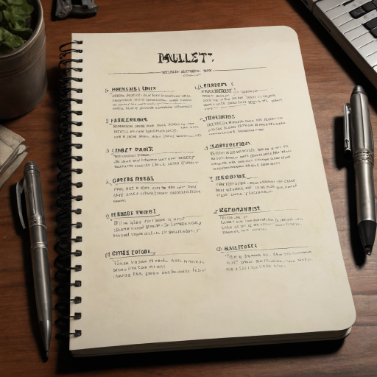Daily Journaling Routine

How, Why, And When To Journal
Journaling, an ancient tradition turned modern-day staple, holds the power to transform lives with just the stroke of a pen. Incorporating journaling into our routine invites a daily practice of introspection and mindfulness, allowing us to process experiences, clarify thoughts, and set intentions. It becomes a personal retreat for organizing thoughts, tracking progress, and nurturing mental health, ultimately contributing to a more centered and reflective life. Let’s have a closer look at how, why, and when to journal.
- Last Updated: July 15, 2025
-
-
Morning Reflections: Starting Your Day with Purpose
Waking up to a new day presents an opportunity for a fresh start, a moment to align our thoughts and set the tone for the hours ahead.
Integrating journaling into your morning routine can set a positive tone for your day, providing clarity and direction.
Famous personalities who focus on self-improvement like Tim Ferriss and others, use “The Artist’s Way – Morning Pages Journal” by Julia Cameron. Tim just puts all his thoughts on the paper to “cage the monkey mind”, as per him.
He says, “I do believe that if you win the morning, you win the day”
Check out Tim Ferriss’ daily routine to know more.
Get your Morning Pages Journal now.
So, here’s how you can use morning journal prompts effectively:
Daily Morning Journal Prompts for Reflection and Goal-Setting
- Prioritize:
Ask yourself, “What are my top three priorities today?” This helps focus your efforts on what truly matters.
- Learn and Apply:
Reflect with, “What lesson did I learn yesterday that I can apply today?” to continuously grow and improve.
What to Journal in the Morning for a Proactive Mindset
- Anticipate Joy:
Start with, “What am I looking forward to today?” to foster a sense of excitement and positivity.
- Action Steps:
Consider, “What action can I take today to move closer to my goals?” to maintain momentum toward your aspirations.
How to Journal in the Morning: Techniques and Benefits
- Time Commitment:
Dedicate five to ten minutes each morning to journaling. The focus is on the process rather than perfection.
Benefits Include:
- Enhanced self-awareness and focus.
- Improved decision-making and problem-solving skills.
- Increased productivity and a stronger sense of direction.
- Greater resilience and a proactive mindset.
-
Choosing the Right Journal
Choosing the right journal is a personal journey, one that reflects your individual needs, aspirations, and style.
Journals for Writing: Finding Your Match
- Purpose and Use:
Consider what you’ll be using the journal for. Is it for daily reflections, creative writing, or tracking goals?
You see, different journals cater to various needs, from bullet journals for the meticulous planner to dream journals for the introspective soul.
You can use the Day One App for your dreams and life, in general.
Emma Watson loves keeping diaries. According to her, “I don’t know what it is. I’ve always kept and collected things, and I’ve always been interested in the idea of diaries. I must have 10 different personal diaries: I keep a dream diary, I keep a yoga diary, I keep diaries on people that I’ve met and things that they’ve said to me, and advice that they’ve given me. I keep an acting journal. I keep collage books.”
- Material and Design:
The tactile feel of a journal can significantly impact your writing experience.
Leather-bound journals offer a sense of permanence and luxury, while eco-friendly options speak to the environmentally conscious writer. Choose a design that inspires you to open it daily.
- Size and Portability:
Your lifestyle plays a crucial role in this choice. A compact journal easily slips into a bag for those always on the go, while a larger format might be better suited for those who journal at home, allowing for more extensive entries.
Writing Journals: A Collection for Every Writer
- The Five-Minute Journal:
Ideal for busy individuals, this journal is designed for quick daily entries that focus on gratitude, planning, and reflection.
Get your 5-Minute Journal now.
Tim Ferriss – a self-improvement and productivity expert, uses the 5-minute journal as part of his morning rituals.
He says, “Five Minute Journal is very helpful for focus, appreciation, and keeping things simple.”
Check out Tim Ferriss’ daily routine to know more.
- The Creative’s Companion:
Artists and writers may gravitate towards blank or dot-grid journals that offer the freedom to sketch, doodle, or write without constraints.
- The Reflective Journal:
Lined journals, possibly with prompts, are great for those who prefer a guided approach to introspection and self-discovery.
- The Goal-Setter:
For those focused on personal or professional development, a structured journal with sections for goal setting, tracking progress, and reflective questions can be incredibly beneficial.
-
Unwinding with Evening Journaling
How to Incorporate Journaling into Your Evening Routine?
- Set a Regular Time:
Just as the sun sets at its appointed time, establish a specific moment in your evening for journaling.
This could be right before bed or as part of winding down after dinner. Consistency helps to solidify this practice as a habit.
- Create a Comforting Environment:
Make your journaling spot inviting. Whether it’s a cozy corner with soft lighting or a snug spot by the window, the right ambiance can enhance your journaling experience, making it something you look forward to each evening.
- Disconnect to Connect:
Before you start, take a moment to disconnect from digital devices. This time is about connecting with yourself, not with the outside world.
Let the quiet of the evening be your backdrop as you reflect and write.
- Keep It Simple:
Don’t pressure yourself to write pages upon pages.
Even a few sentences reflecting on the day or jotting down what you’re grateful for can be incredibly powerful.
Evening Journaling Prompts for Relaxation and Introspection
- Gratitude Reflection:
“What am I grateful for today?” Gratitude journaling can shift focus from daily stresses to the positive aspects of your life, fostering a sense of contentment.
- Achievements of the Day:
“What accomplishments, big or small, did I achieve today?” Acknowledging your successes can boost your self-esteem and motivation.
- Lessons Learned:
“What lessons did today teach me?” Reflecting on the day’s learnings can provide valuable insights for personal growth.
- Mood Inventory:
“How did I feel throughout the day, and why?” This question encourages emotional awareness and can help identify triggers for stress or happiness.
- Dreams and Aspirations:
“What dreams or goals did I ponder today?” The evening is a perfect time to daydream and set intentions for the future, planting seeds for the days ahead.
-
Nighttime Journaling
How to Include Journaling into Your Nighttime Routine
- Create a Pre-Sleep Ritual:
Integrate journaling into your pre-sleep ritual to signal to your body that it’s time to wind down.
This could be after you’ve changed into your nightwear and before you turn off the bedside lamp.
- Limit Artificial Light:
To preserve your circadian rhythms, opt for low lighting.
A dim lamp or even candlelight can set the perfect mood for nighttime journaling without disrupting your sleep hormone production.
- Make It Accessible:
Keep your journal and a pen on your nightstand.
This reduces barriers to journaling and makes it easier to jot down thoughts spontaneously, even in the middle of the night.
- Focus on Relaxation:
Your night journaling should not be about problem-solving or planning the next day. Instead, focus on reflections that induce calm and gratitude.
As per actor Joseph Gordon-Levitt, “I like to write. I’ve gone through different phases in my life of writing in a journal more or less frequently, but it’s something I turn to, especially when I’m trying to work through something that’s vexing me.”
What to Journal About at Night to Calm the Mind and Prepare for Rest
- Positive Events:
“What made me smile today?” Focusing on positive events can uplift your mood and ease anxiety, fostering a sense of peace before sleep.
- Gratitude List:
Make a list of things you’re grateful for from the day. Gratitude journaling has been shown to improve sleep quality by shifting focus away from stressors.
- Letting Go:
“What do I need to let go of before I sleep?” Write about worries or challenges, then visually imagine them leaving your mind as you close your journal. This act can be incredibly freeing.
- Affirmations:
End your journaling session with positive affirmations. Phrases like “I am at peace” or “I did my best today, and that is enough” can be soothing reminders that contribute to a restful state of mind.
- Dream Descriptions:
If you wake in the night from a dream, jotting down what you remember can not only help you fall back asleep but also provide fascinating insights into your subconscious.
-
Journaling Tips
Whether you’re new to journaling or looking to deepen your existing routine, these tips can help you harness the full potential of your journaling practice.
How to Journal
- Just Start:
The first step is often the hardest. Begin by writing anything that comes to mind. It doesn’t have to be coherent or profound. The act of starting breaks down barriers and initiates momentum.
- No Judgments:
Allow your journal to be a judgment-free zone. This is your private space to express thoughts and feelings without censorship or worry about grammar and spelling.
- Consistency Over Quantity:
It’s more beneficial to journal a little each day than to write pages sporadically. Aim for consistency to develop a habit, even if it’s just a few sentences each day.
- Use Prompts:
If you’re unsure what to write about, prompts can be incredibly helpful. They can guide your thoughts and help you explore different areas of your life.
- Reflect:
Make time to read back through your entries occasionally. This can provide insights into your personal growth and patterns in your thoughts and behaviors.
5 Tips for Creating a Self-Care Journal Ritual
- Dedicate a Specific Time:
Choose a time of day for your journaling ritual. Morning may help set the tone for the day, while evening can serve as a reflective practice to unwind.
- Create a Comfortable Space:
Journal in a space where you feel relaxed and at ease. This could be a cozy chair with your favorite blanket, a peaceful spot in your garden, or anywhere that feels special and comfortable to you.
- Incorporate Other Self-Care Elements:
Combine your journaling with other self-care activities. Light a candle, play soft music, or have a cup of tea as you journal to enhance the experience.
- Focus on Feelings and Needs:
Center your entries on your emotions, needs, and desires. Ask yourself how you’re feeling, what you need more or less of in your life, and ways to nurture yourself.
- Include Gratitude:
Regularly write about things you’re grateful for. Gratitude journaling can shift your focus from what’s lacking to what’s abundant in your life, fostering positive emotions.
-
The Art of Bullet Journaling
What is Bullet Journaling?
Bullet journaling is a method developed by Ryder Carroll.
According to Ryder Carroll: “[The bullet journal] helps you track the past, organize the present, and plan for the future“
It uses a system of rapid logging, symbols, and indexes to keep information easily accessible and manageable.
At its core, bullet journaling is about efficiency, simplicity, and mindfulness, encouraging users to live more intentional and productive lives.
7 Tips for Bullet Journaling: Maximizing Organization and Creativity
- Start with the Basics:
Begin your bullet journal with an index, a future log, a monthly log, and a daily log.
These foundational elements will help you track your tasks, events, and notes efficiently.
- Use Symbols and Signifiers:
Develop a system of symbols that work for you (e.g., circles for events, dots for tasks, dashes for notes).
Signifiers can add additional meaning, like an asterisk for priority tasks or an exclamation point for ideas and inspirations.
- Create Collections:
Collections are pages dedicated to specific topics, projects, or trackers (like books to read, habit trackers, or fitness goals).
They can be added anywhere in your journal and indexed for easy reference.
- Customize to Your Needs:
The beauty of a bullet journal is its adaptability. Incorporate elements that serve your lifestyle and goals, whether that’s meal planning, workout logs, or meditation trackers.
- Keep It Simple or Get Creative:
While some enjoy the simplicity of minimalistic bullet journals, others use their pages as a canvas for creativity, incorporating doodles, calligraphy, and washi tape. Choose a style that inspires you to use your journal regularly.
- Review and Reflect:
Regularly review your entries to assess what’s working and what isn’t. This reflection can help you refine your system and ensure your bullet journal evolves with your changing needs.
- Embrace Imperfection:
Don’t worry about making mistakes. Bullet journaling is a personal process that’s meant to be functional. Imperfections can add character and make your journal uniquely yours.
-
The 10 Surprising Benefits of Journaling
1. Enhanced Self-Awareness
Keeping a journal, whether it’s filled with dreams from the night before or reflections on daily life, acts as a mirror for our inner world.
It encourages a dialogue with oneself, leading to greater self-understanding and awareness.
This introspective practice allows individuals to notice patterns in their thoughts and behaviors, paving the way for personal growth.
2. Boost in Creativity
Journaling isn’t just about recording the day’s events; it’s also a limitless canvas for creativity. Evening and nighttime journal prompts can spark the imagination, transforming quiet moments into sessions of creative exploration.
This practice nurtures an inventive mindset, encouraging the birth of new ideas and perspectives.
3. Stress Relief and Mental Health Support
The therapeutic benefits of journaling are well-documented. By putting thoughts and feelings onto paper, individuals can process emotions more effectively, reducing stress.
Self-care journals and prayer journals, in particular, offer a spiritual or introspective approach to coping, providing a source of comfort and emotional release.
According to Andrew Huberman, “Journaling is very powerful…It is also just talking to a trusted friend even if they don’t respond.”
4. Goal Setting and Achievement
Bullet journaling, with its emphasis on organization and planning, along with the use of morning journal prompts, can significantly enhance one’s ability to set and achieve goals.
This structured approach to journaling helps clarify objectives, break them down into actionable steps, and track progress, turning aspirations into reality.
5. Memory Enhancement and Cognitive Processing
The act of writing by hand engages the brain in a unique way, improving memory and aiding in the cognitive processing of events.
Journaling creates a personal archive, capturing moments and lessons learned, which can be revisited and reflected upon in the future.
6. Improved Problem-Solving Abilities
Journaling offers a private space to untangle thoughts and navigate complex emotions, fostering enhanced problem-solving skills.
By writing about challenges, individuals can distance themselves from their problems and often stumble upon solutions or alternative approaches they hadn’t considered.
7. Building Empathy and Emotional Intelligence
Regular journaling encourages individuals to confront and understand their emotions, fostering emotional intelligence.
This reflective practice can lead to a deeper empathy for oneself and others, as it promotes an understanding of the vast spectrum of human emotions.
8. Strengthening Self-Discipline and Consistency
The ritual of daily journaling, whether in the morning or evening, cultivates self-discipline and consistency.
This routine not only establishes a productive habit but also instills a sense of reliability and commitment within oneself.
9. Creating a Personal Historical Record
Journals serve as a tangible record of personal growth and life history, offering unique insights into one’s journey.
They capture the evolving story of an individual’s life, holding memories and experiences that can be cherished and learned from for years to come.
10. Improved Writing and Communication Skills
Engaging regularly with a journal naturally hones writing skills. This practice not only improves grammar and vocabulary but also clarifies thought processes, enhancing verbal communication skills.
For students and professionals alike, the benefits of this improved articulation are invaluable.
One significant benefit of journaling for students is the enhancement of their reflective thinking skills.
It aids in critical analysis and improved decision-making skills, which are essential for both academic success and personal growth.
-











